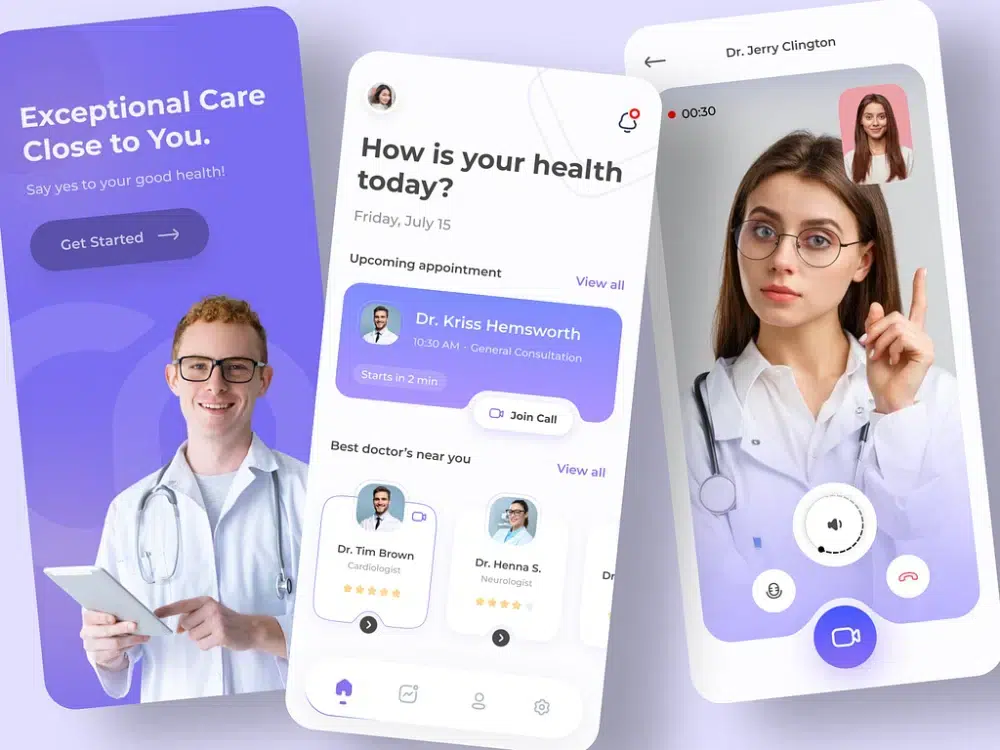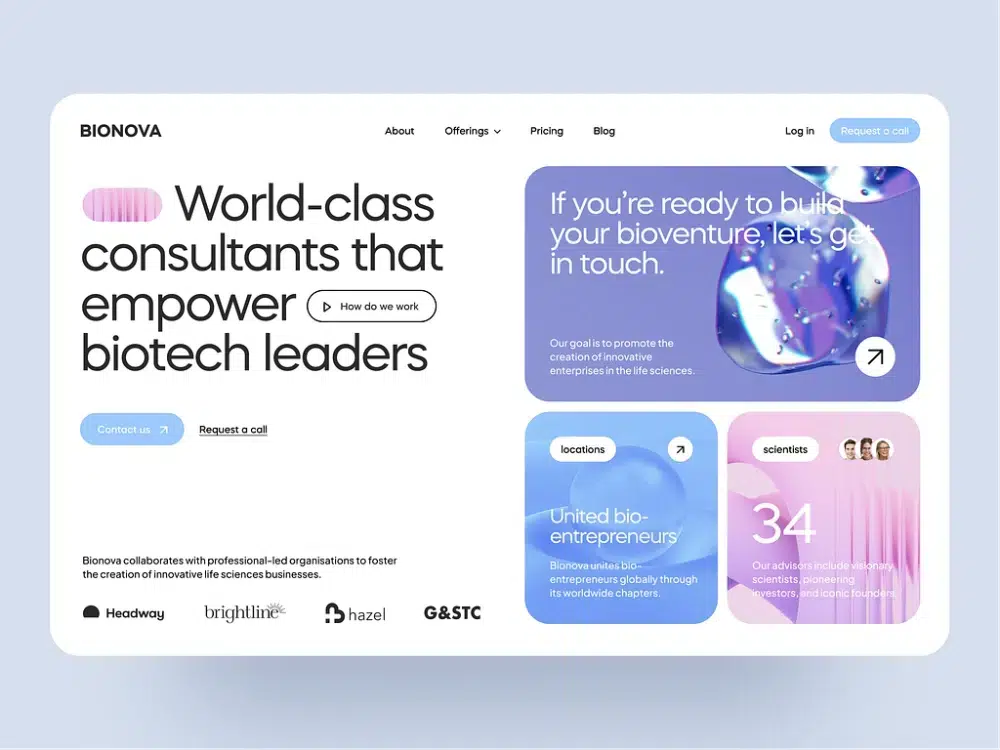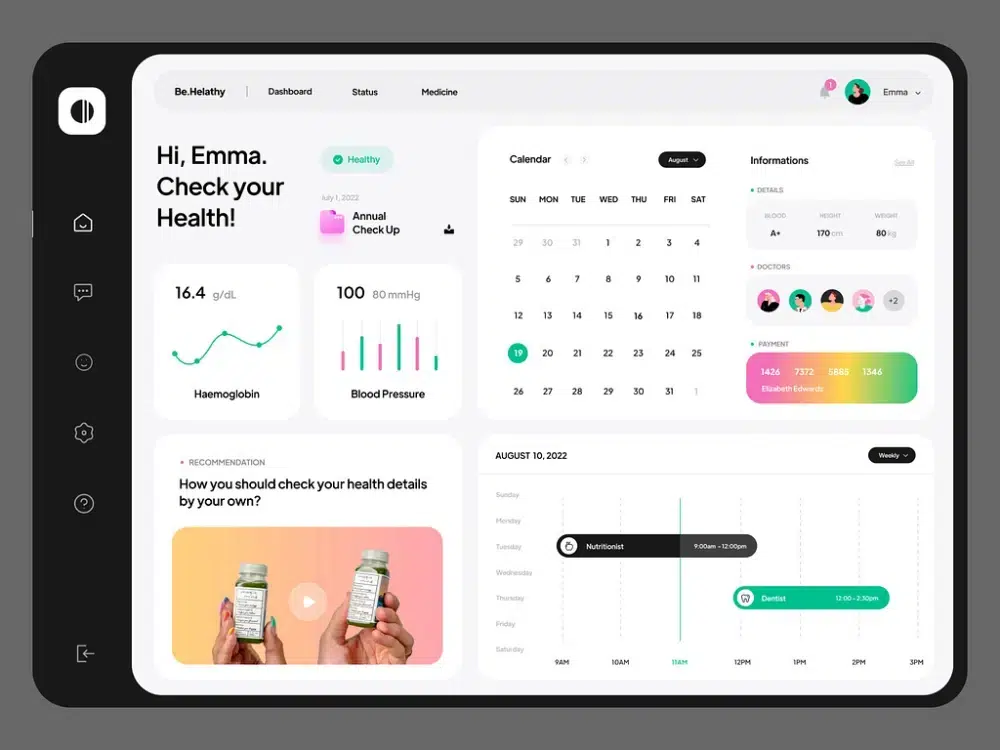EDI in Healthcare: What Is It and Why Does It Matter?
Before electronic data interchange (EDI in healthcare), the healthcare business looked like this: massive records, heaps of paper, and hundreds of returned claims. Using EDI in healthcare helps medical businesses protect data exchanges, speed up information turnaround, and eliminate claim processing delays. All of this makes EDI implementation an integral part of providing high-quality care and enhancing patient engagement systems.
Whether you are developing a new healthcare solution or already have EDI in healthcare software and wish to optimize its benefits, this article will help you understand the value of EDI in healthcare, how to use it in practice, and how to integrate it into your system, particularly with electronic health record integration and customizable EHR solutions.
1. What is EDI in healthcare?

EDI in healthcare stands for Electronic Data Interchange. It’s a system that allows computer systems to exchange and use information. In the context of healthcare, EDI in healthcare provides a standard format for exchanging health care data between various health organizations like hospitals, insurance companies, and government entities. The standards typically used in healthcare EDI are HL7 (Health Level Seven International) and X12.
For decades, many sectors have relied on EDI in healthcare for dependable, effective electronic document exchange, particularly for speedy document transmission with corporate partners, clients, or internally. EDI in healthcare is a secure method of exchanging data between healthcare institutions, insurers, and patients. EDI allows for the electronic exchange of various healthcare documents, such as medical claims processing, invoices, patient data, and prescriptions, using defined formats and procedures.
Healthcare EDI transaction types
Here’s a table summarizing the 10 different types of HIPAA compliance electronic data interchange transactions used by healthcare organizations:
| Transaction Type | Description |
|---|---|
| Healthcare Claim Transaction Set (837) | Enables healthcare professionals and patients to submit healthcare claims and encounter data. |
| Retail Pharmacy Claim Transaction | Retail pharmacy claims can be submitted by healthcare providers and regulatory organizations. |
| Healthcare Claim Payment/Advice Transaction Set (835) | Used by insurers to make payments and send Explanation of Benefits (EOB) remittance guidance. |
| Benefits Enrollment and Maintenance Set (834) | Used by employers, unions, and healthcare organizations to enroll people in a healthcare benefit plan. |
| Payroll Deducted and Other Group Premium Payment (820) | Used by healthcare organizations to make premium payments for insurance policies. |
| Healthcare Eligibility/Benefit Inquiry (270) | Sends inquiries about healthcare benefits and subscriber eligibility to agencies. |
| Healthcare Eligibility/Benefit Response (271) | Responds to inquiries regarding a subscriber’s healthcare benefits and eligibility. |
| Healthcare Claim Status Request (276) | Allows healthcare providers to request or verify the status of previously submitted claims. |
| Healthcare Claim Status Notification (277) | Used to report on the status of claims submitted by providers. |
| Healthcare Service Review Information (278) | Allows hospitals to obtain authorization from a payer. |
To choose the best healthcare EDI transaction type for your business, it’s important to analyze your organization’s needs, take industry standards into account, consult with trade partners, and comply with regulations. This will ensure an informed and wise decision for your healthcare business.
2. How EDI in healthcare works

EDI in healthcare works by facilitating the secure and effective transmission of electronic data among various institutions in the healthcare ecosystem.
- Standardized formats: When exchanging data through EDI, specific formats such as ANSI X12 or HL7 are used. These formats ensure that the data is arranged in a consistent manner that is easy for both the sender and recipient to comprehend. This guarantees that everyone involved in the process understands the shared information clearly.
- Data translation: Before being transmitted, healthcare data undergoes a transformation process to be converted into the appropriate EDI format. This involves converting data from internal systems like electronic health records (EHRs) or practice management systems into a standardized EDI-compliant format.
- Data transmission: Once in EDI format, the data is electronically exchanged between the sender and the recipient via secure communication protocols such as FTP (File Transfer Protocol) or AS2 (Applicability Statement 2). This helps maintain the integrity and confidentiality of data while in transit.
- Data validation: The recipient validates the EDI data after receiving it to guarantee its accuracy and compliance with preset rules and standards. Validating data items such as patient identities, procedure codes, or insurance information against relevant databases or reference systems is part of this process.
- Data processing: The recipient’s systems process the EDI healthcare data after it has been validated. Depending on the exact purpose of the EDI transaction, this may include updating patient information, generating claims, processing payments, or performing other administrative and clinical duties. This integration is often facilitated by healthcare CRM systems that enhance the overall efficiency and patient interaction experience.
- Acknowledgment and response: After the recipient processes the EDI data, they will send an acknowledgment or response back to the sender. This acknowledgment will confirm that the data was received and may include additional information such as claim acceptance, payment details, or error notifications.
3. Uses and Benefits of EDI

The primary goal of EDI in healthcare is to improve accuracy and the overall quality of patient care by streamlining administrative processes. According to the Workgroup for Electronic Data Interchange (WEDI), implementing EDI can reduce healthcare administrative costs by 30%. Healthcare organizations can eliminate errors, reduce paperwork, and accelerate information flow by replacing manual and paper-based processes with EDI.
- Standardization: By utilizing standardized formats, the transfer of patient health information (PHI) is made more secure and efficient. Implementing EDI in healthcare has led to a significant improvement in data quality, as it requires all parties to follow universal standards instead of multiple formats.
- Lower administrative expenses: EDI in healthcare reduces costs associated with document processing since the majority of data is digital. The American Medical Association (AMA) reports that electronic claims save about $1.10 per claim compared to paper claims.
- Higher security: EDI transactions enhance secure communication between authorized parties, mitigating risks associated with data breaches. As healthcare organizations seek to understand how to secure health data, EDI provides robust options for encryption and secure transfer protocols. Additionally, HIPAA regulations ensure that only authorized individuals have access to the data, further enhancing security. Finally, all files are shared through B2B file transfer using secure protocols such as AS2, MLLP, and SFTP.
- Enhanced accuracy: EDI allows for faster, more efficient data exchange. Instead of manually sending paper documents and then waiting for the other party to enter data into their systems, data can be sent and processed digitally, dramatically reducing the time required for data exchange. HIPAA EDI software solutions help medical businesses streamline their key transactions. Aside from enhanced productivity, it results in fewer human mistakes, like typos, incorrect entries, or lost faxes/mail. Furthermore, all EDI files are subjected to extensive testing and validation. Snip Levels is a method that validates healthcare EDI files across seven levels to ensure they include the relevant information.
- Improved productivity: EDI in healthcare enhances efficiency by enabling real-time interactions and driving timely data delivery without errors. This is particularly significant when considering IoT applications in healthcare, which further optimize data flows.
- Compliance: EDI systems can embed data security features to help meet legal requirements around data security in healthcare.
4. How to make your healthcare system EDI compliant
Follow these steps to implement EDI in your healthcare business.
Step 1. Consider your company’s needs
To successfully implement EDI in healthcare, you should first establish clear requirements and goals. Take the time to evaluate your internal systems and determine if they are ready for integration.
Additionally, identify any challenges or improvements you hope to achieve through EDI. If you need assistance in determining the feasibility and potential benefits of EDI for your company, consider consulting with a qualified IT provider.
Step 2. Select an experienced technical partner
Find a reputable and competent technology partner, such as healthcare app development companies, experienced with healthcare EDI. Together, develop a thorough plan and strategy for incorporating EDI into your current systems.
On websites like Clutch, which provide verifiable ratings and evaluations for software development vendors worldwide, you can start by doing research on reliable software development companies. Pay close attention to the vendors’ EDI implementation experience, familiarity with industry standards and laws, and capacity to comprehend your unique requirements. Consider their experience in data security and compliance as well to guarantee the privacy and safety of critical healthcare data.
Step 3. Development and integration of EDI software
Work with your IT partner to create or choose healthcare EDI software that suits the requirements of your firm. Integrate the EDI solution with your current systems, such as practice management systems, electronic health record (EHR) systems, or billing systems. Make sure all systems can communicate and interact with one another seamlessly.
Step 4. EDI transaction testing and validation
To ensure your EDI transactions comply with the necessary regulations and are compatible with your trading partners’ systems, thoroughly test and validate them. During transmission and reception, check the data’s precision and integrity.
Step 5. Internal training
Employees who will be utilizing the EDI system should receive training from your company. Inform them of the transaction sets, procedures, and policies that apply to the installation of medical EDI in your organization. Ensure they know how to use the EDI software well and appreciate its advantages to their everyday work.
Step 6. EDI support
Maintain consistent communication and cooperation with your IT partner to address any EDI system-related problems, upgrades, or improvements. Stay informed on EDI standards or law changes to ensure compliance and top performance. Evaluate the healthcare EDI implementation’s performance on a regular basis and make the required adjustments to optimize its advantages.
As part of their digital strategies, organizations can also explore healthcare digital transformation consulting services to enhance their EDI implementation, incorporating tech innovations in healthcare that can further streamline processes.
By following these guidelines, healthcare organizations can effectively implement EDI in healthcare, ensuring optimal data management, improved patient care, and compliance with industry standards. Increased focus on electronic health record integration and the use of RPA in healthcare are critical components of this transformation journey.
FAQ
1. What is EDI in healthcare?
EDI (Electronic Data Interchange) in healthcare is a standardized method of electronically transferring medical information between providers, insurers, and other parties. It replaces paper-based processes to streamline data exchange and improve accuracy.
2. How does EDI improve healthcare operations?
EDI automates claims processing, billing, enrollment, and reporting, which reduces errors, cuts administrative costs, and speeds up communication between healthcare stakeholders.
3. What are the most common healthcare EDI transaction types?
Common types include healthcare claim submission (837), payment/advice (835), benefit enrollment (834), eligibility inquiry/response (270/271), and claim status updates (276/277).
4. How do healthcare systems become EDI-compliant?
Healthcare systems must define their requirements, select experienced tech partners, develop or integrate compliant EDI software, test transactions, train internal staff, and maintain ongoing support and compliance updates.
5. What are the challenges of implementing EDI in healthcare?
Challenges include technical complexity, the need for secure integration with existing systems, compliance with HIPAA standards, and staff training requirements.
Savvycom – Your Trusted Tech Partner
From Tech Consulting, End-to-End Product Development to Outsourcing in Healthcare Services! Since 2009, Savvycom has been harnessing the power of Digital Technologies that support business’ growth across the variety of industries. We can help you to build high-quality software solutions and products as well as deliver a wide range of related professional services.
Savvycom is right where you need. Contact us now for further consultation:
- Phone: +84 24 3202 9222
- Hotline: +84 352 287 866 (VN)
- Email: [email protected]


